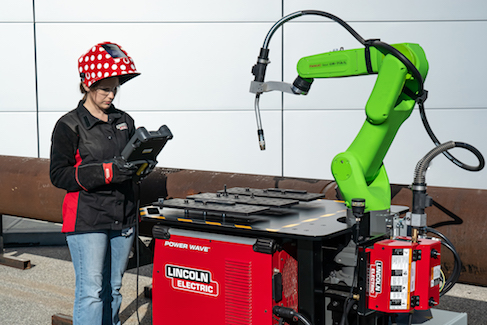A Primer on Cobotic Welding
More than 20% of commercial welding in the United States is done by a robot, a percentage that will grow as fabricators look for ways to streamline production. Collaborative robots (cobots) make automation a cost-effective proposition even for small shops.
Posted: March 3, 2021
BY PETER GRIFFITH
Industrial welding robots help their human coworkers move parts, handle material, palettize, assemble, torque, and by bringing parts to the welder. While they work well for large-scale applications that can afford to buy a robot designed to perform just one task, small shops generally don’t have the consistently high volume necessary to justify a welding cell that must also be fenced or otherwise safeguarded to protect employees from injury.
Collaborative robots (cobots) allow fabricators to reap the benefits of automation without an industrial robot’s large footprint or price tag. Because they don’t require programming language expertise, they’re relatively easy to learn and deploy – making them cost-effective for lower-volume production runs with a higher mix of part sizes and design features. As a result, they’re crucial to alleviating the impact of fewer skilled welders entering the trade.
Because they generally don’t require safeguarding, cobots consume less floor space than an industrial robotic welding cell. Their smaller footprint provides greater flexibility and more opportunities to automate tasks.
Nor are they intended to replace human welders. Instead, they automate dirty, dangerous, and dull welding-related tasks so their human counterparts can enhance a shop’s capabilities – and profitability – by producing more complex work.
Add Flexibility Without Sacrificing Safety
As the need for automation grows, smaller shops are asking for solutions that fill the void in the overall robot market for welding.
To meet this need, we developed a compact and adaptable robotic solution that safely and effectively works alongside skilled welders and production employees. As its name implies, the Fab-Pak Cobot Cart is a Fanuc CR-7iA arc welding robotic arm mounted on a wheeled cart that’s locked into place and stabilized with a kickstand. Unlike traditional robots, the cart fits through a standard doorway and can run on lower voltage power so it can be moved and operated virtually anywhere.
Designed to Robotic Industries Association (RIA) standards, power and force-limiting sensors in the robotic arm protect welders and production staff working near the cart with speed and separation monitoring. Fanuc’s iRVision visual detection system for even faster production can be added as an option.
Lincoln Electric’s Power Wave R450 power source with optional surface tension transfer (STT) advanced waveform system and AutoDrive feeder system for up to 0.045-inch wire provides fast travel speeds, low spatter, superior gap bridging and excellent penetration. Available for a variety of wire sizes and bends, the Magnum PRO robotic torch provides a high-performing arc for air-cooled welding rated at 550A at 100% duty cycle.
Unlike traditional robotic workstations and other cobotic solutions, the cart can be configured for standard MIG and twin-wire, heavy-deposition welding on steel and aluminum with touch-sense technology, weaving and seam tracking. Options include torch angle control, lead-through teach, and auxiliary axis support.
The cart comes with brackets for mounting a gas bottle. Options include modular fixturing and fume extraction.
Helping You Optimize Your Workforce
We offer a comprehensive training program to ensure welders of all skill levels get the knowledge they need to improve. The program covers basic robotic programming, and one module focuses on differences between traditional and collaborative robotics.
Whether traditional or collaborative robotics, we want customers to understand the products they purchase so they can operate in the safest and most effective way possible. Part of the training is dedicated to safety, with information on what personal protective equipment (PPE) to wear and safety precautions they should take while using our products.
Training is typically offered 46 weeks of the year but, due to safety precautions surrounding COVID-19, in-person training at our Cleveland-based Lincoln Electric Automation facility has been temporarily reduced. Virtual training is available for those unable to attend in person.












